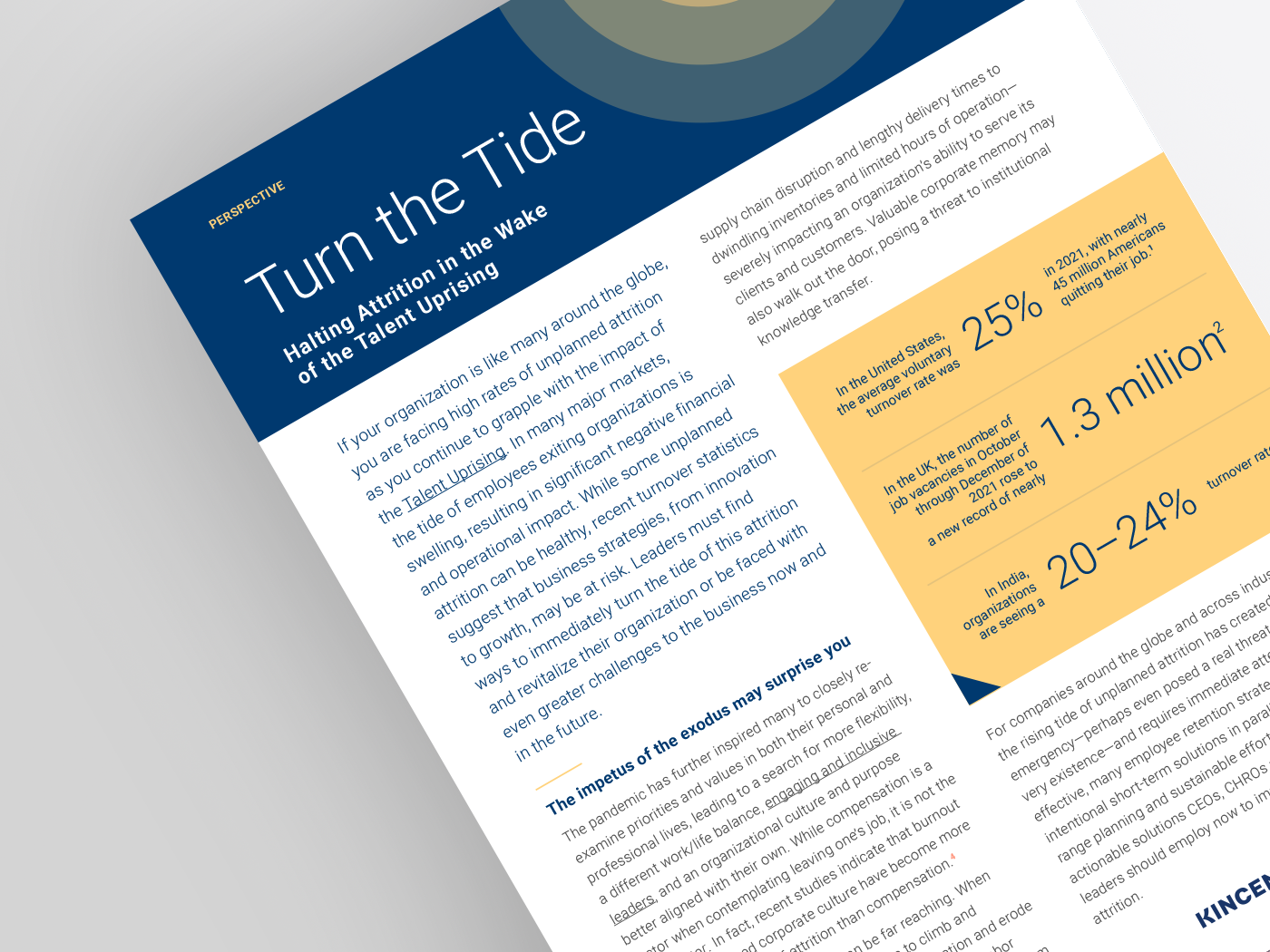
If your organization is like many around the globe, you are facing high rates of unplanned attrition as you continue to grapple with the impact of the Talent Uprising. In many major markets, the tide of employees exiting organizations is swelling, resulting in significant negative financial and operational impact. While some unplanned attrition can be healthy, recent turnover statistics suggest that business strategies, from innovation to growth, may be at risk. Leaders must find ways to immediately turn the tide of this attrition and revitalize their organization or be faced with even greater challenges to the business now and in the future.
The pandemic has further inspired many to closely re-examine priorities and values in both their personal and professional lives, leading to a search for more flexibility, a different work/life balance, engaging and inclusive leaders, and an organizational culture and purpose better aligned with their own. While compensation is a factor when contemplating leaving one’s job, it is not the only factor. In fact, recent studies indicate that burnout and a misaligned corporate culture have become more significant drivers of attrition than compensation.4
The impact of this attrition can be far reaching. When employees leave, it can cause costs to climb and productivity to plummet, impede collaboration and erode key internal and external relationships. Severe labor shortages can result in a host of business issues—from supply chain disruption and lengthy delivery times to dwindling inventories and limited hours of operation—severely impacting an organization’s ability to serve its clients and customers. Valuable corporate memory may also walk out the door, posing a threat to institutional knowledge transfer.
For companies around the globe and across industries, the rising tide of unplanned attrition has created a true emergency—perhaps even posed a real threat to their very existence—and requires immediate attention. To be effective, many employee retention strategies require intentional short-term solutions in parallel with long- range planning and sustainable efforts. There are several actionable solutions CEOs, CHROs and organizational leaders should employ now to immediately address attrition.
Start with a clear understanding of not only the scope of attrition, but a sense of exactly which employees are leaving and why and how this impacts your business— now and in the future. Dig into the data of who is leaving to detect patterns and early warning signs. Are you seeing more attrition within certain functions or tenure levels, or at certain seniority levels? This could be due to a lack of growth opportunities or unclear career paths. Are more employees leaving in certain regions, divisions or teams? This might indicate a problem with leadership or specific people managers who may not have the resources, tools or capabilities to manage in this new way of working. Also, if you’re seeing attrition within underrepresented talent, dig deeper to better understand the intersectional experiences of your employees (e.g., gender, race/ethnicity, generation, nationality, tenure, career level, etc.) and bring these to light. With this root cause insight, you can tailor your solutions for maximum impact.

There are several tools you can utilize to identify the root cause of your Talent Uprising. Start by examining the data from your annual employee insight or engagement survey and consider conducting additional, quick pulse surveys to pinpoint problems. Where are you seeing higher levels of disengagement or signs of burnout? Also look at linkage between drivers of engagement and resignation data to further uncover specific retention risk factors. Segmenting this data by certain cuts (e.g., your growth markets, key capabilities needed to grow your business, high-potential talent, underrepresented talent, etc.) will enable you to identify and focus your efforts where the business impact will be the greatest. You can also overlay “big data” to calculate the cost of turnover and get a clearer diagnosis regarding the total impact on your bottom line and future growth prospects.
Also collect and analyze exit data. Look for actionable insights and actions you can take now to turn the tide of attrition. It is important to understand why employees are leaving, where they’re going and what you might have done differently to retain them. As departing employees may not always feel comfortable disclosing the real reasons for leaving, consider engaging a third party now to conduct exit interviews to encourage candid disclosure and deeper actionable insights.
Once armed with this insight, expediency and a targeted focus will become crucial. HR plays a critical role here in setting and enabling the retention strategy and partnering with the leadership team and people leaders across the organization to take action in a prioritized and agile way. In collaboration with HR, business leaders should take a holistic view to understand which roles are truly critical to their operation. Identify where the business impact of attrition could be greatest, including functions/roles that are directly responsible for generating revenue, contribute to critical workflows or require company- or role-specific knowledge.
Next, consider conducting a “Stop, Start, Continue” analysis to identify and eliminate non-mission-critical work in order to conserve resources and preserve morale. Being resource constrained and feeling overworked can quickly lead to frustration and burnout, one of the leading causes of attrition. Hold team “huddles” to identify and prioritize critical work in an agile and informed way, drawing on the wisdom of those who deliver day in and day out to identify the tasks that really make a difference. Look to streamline operations and create efficiencies using new tools and technologies and consider utilizing consultants, contingency workers or recent retirees to fill the labor or expertise gap.
There are a number of tactics you can utilize now to prevent attrition. One of the most valuable tools you have at your disposal is the stay interview. Stay interviews offer your organization a preemptive opportunity to identify problems, change policies and practices that may be contributing to a high attrition rate, and take action in the short term. Stay interviews can also aid in building trust and employee loyalty. Because time is of the essence, focus on conducting stay interviews first with your prioritized groups—employees in critical roles and those who are flagged in your succession plans, high- potentials and underrepresented talent—but do it NOW. Stay interviews help you stem attrition now and provide a longer-term way to address retention in a scalable way that sustains the impact.
There are several best practices to utilize when conducting stay interviews. Be transparent as to why you wish to have the conversation. Doing so will help build trust and create a psychologically safe environment in which your employees can more genuinely share their opinions and feelings, leading to a more meaningful dialogue. If your culture is not one in which people can share their feedback without fear of judgment or reprisal or where cultural norms may prevent employees from sharing, you will need to work on establishing rapport, trust and psychological safety with your employees before these can be effective. Always ask your employees “What do you need right now?” and be open and responsive to their feedback. Equipped with these deeper insights, agree on short, time-bound and specific actions with accountabilities and timelines.
While stay interviews are best held between an employee and their direct supervisor, if you suspect the problem lies with a specific manager, consider bringing in a leader from another team or a representative from HR to conduct the interview. Lastly, stay interviews or “skip level” discussions can help you determine how you measure against competing employers. Be sure to ask about what your employees are seeing in the marketplace relative to what they’re experiencing with your organization. This can help you evaluate your own programs and practices and ensure they are comparable or better.
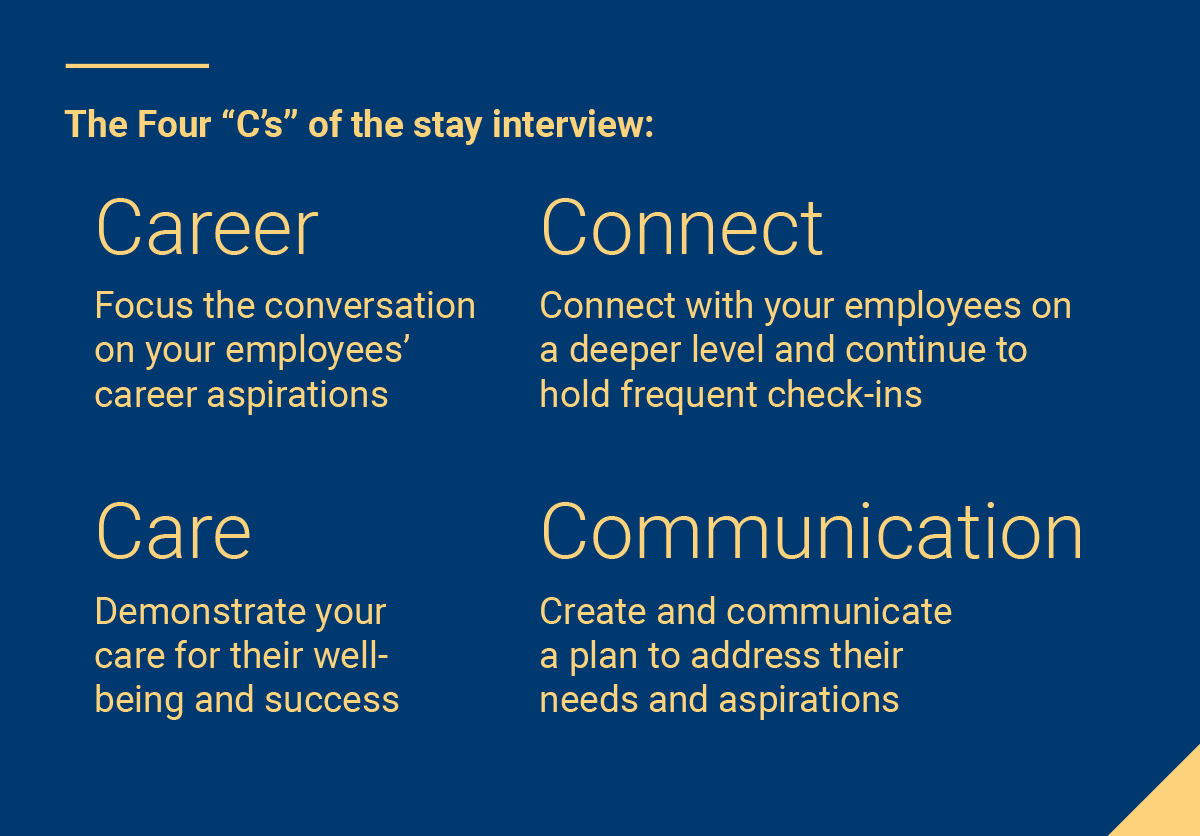
Honesty, transparency and open communication with your employees are never more imperative than when you are faced with a crisis. It is important to acknowledge that this is a difficult time and to express your appreciation for your employees’ commitment, dedication and hard work. Managers should make the effort to demonstrate care and compassion and build a deeper connection with their team members, thanking each one of them for their perseverance and extra effort in the face of a labor shortage. Now is also the time to step up recognition and reward programs to demonstrate this appreciation. Recognition is proven to increase engagement and productivity as well as loyalty. Be sure your recognition program is tied to what is important to your organization, values and goals.
Replacing key employees and recruiting new talent can take weeks or even months, but you may have immediate access to an untapped pool of internal talent at your disposal. Look to better match the work that needs to be done with the talent you already have. This may require some upskilling, reskilling, cross-training or even intensive, immersive job shadowing for a brief period of time. Contingency workers and freelancers can help in the interim. Additionally, consider reaching out to recent retirees who may be interested in working part-time, on call or on a project basis or who may be willing to train existing employees willing to take on new responsibilities.
If you must seek fresh talent, do what you can to expedite the process. Consider recruiting employees who left in good standing—your “boomerangs.” Provide referral bonuses to motivate your employees to get involved but be vigilant about how these bonuses could perpetuate affinity bias, which can work against your diversity, equity and inclusion goals. Re-examine your job descriptions. Does a role truly require a four-year degree or experience in your industry? Find new places to recruit, such as job fairs, community colleges and even social media platforms such as Twitter. Meet candidates where they are using virtual hangouts, shared interest group events, etc. Streamline the interview process to empower hiring managers to make quick decisions.
While the Talent Uprising has had a profound impact on many organizations, it isn’t all gloom and doom. Smart leaders will recognize that they have an opportunity to create meaningful changes in the workplace, the workforce and the work itself at an incredibly accelerated pace. The Talent Uprising has opened opportunities for a workforce “revitalization”—enabling organizations to achieve the right mix of diversity with a focus on underrepresented talent as well as new skills and perspectives. This allows you to better align with where your organization is moving over the next three to four years more easily.

Make no mistake about it—there is a new employee/ workplace paradigm. As the Talent Uprising underscores, some organizations have not shifted their mindset to embrace new ways of working, and ignoring these new dynamics may trigger the need for more drastic and expensive measures down the road. As you adapt your ways of working and your business strategy, you must also adapt your culture to attract and retain your workforce and revitalize your organization in the wake of the pandemic. While the Talent Uprising has created a sense of urgency to act now, leaders must look to the future to ensure their organizations are well positioned for success going forward—and emerge even stronger.
1. US Bureau of Labor Statistics JOB OPENINGS AND LABOR TURNOVER – DECEMBER 2021; https://hrexecutive.com/number-of-the-day-employees-who-have-quit/
2. https://www.ons.gov.uk/employmentandlabourmarket/
3. https://www.monster.co.uk/advertise-a-job/hr-resources/workforce-management-and-planning/
4. https://sloanreview.mit.edu/article/toxic-culture-is-driving-the-great-resignation/?inf_contact_
We would like to thank Jill Kissack, Michael Martin and Seymour Adler for contributing their insights to this article.
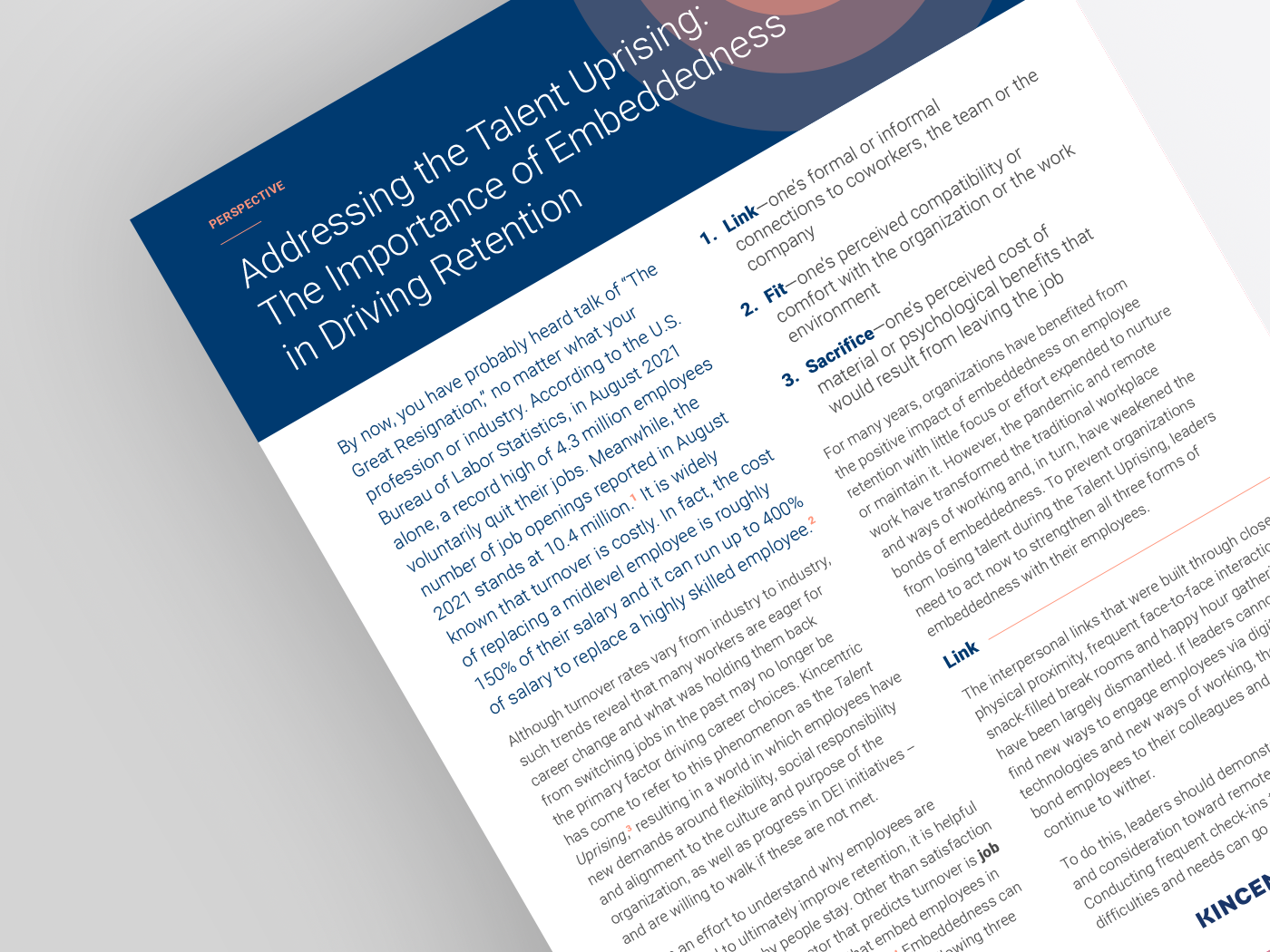
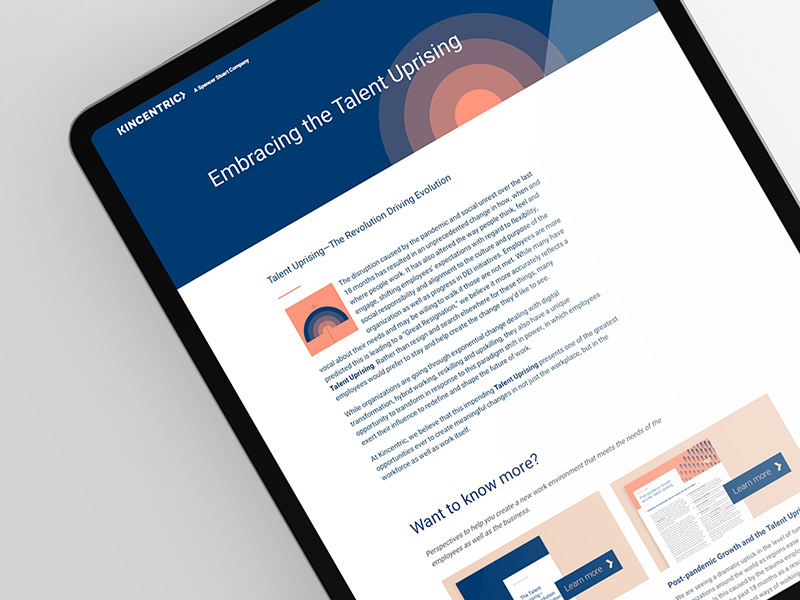
Employees have become more vocal about their needs, and resignations are on the rise, leading to a Talent Uprising, in which employees have a stronger say in dictating the terms of their employment. Organizations must create a new work environment that meets the needs of their employees as well as the business.
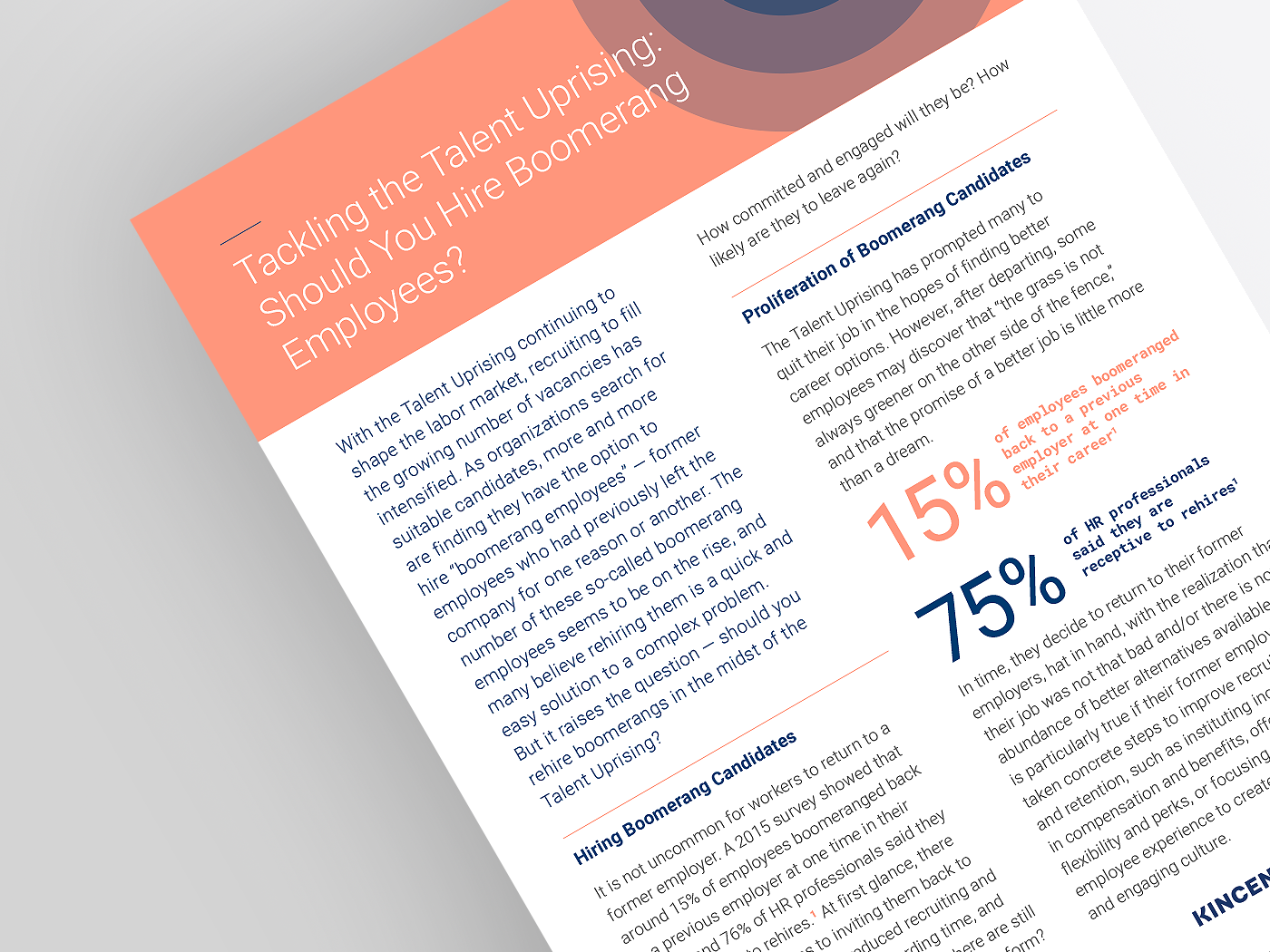
Want the latest insights delivered straight to your mailbox?